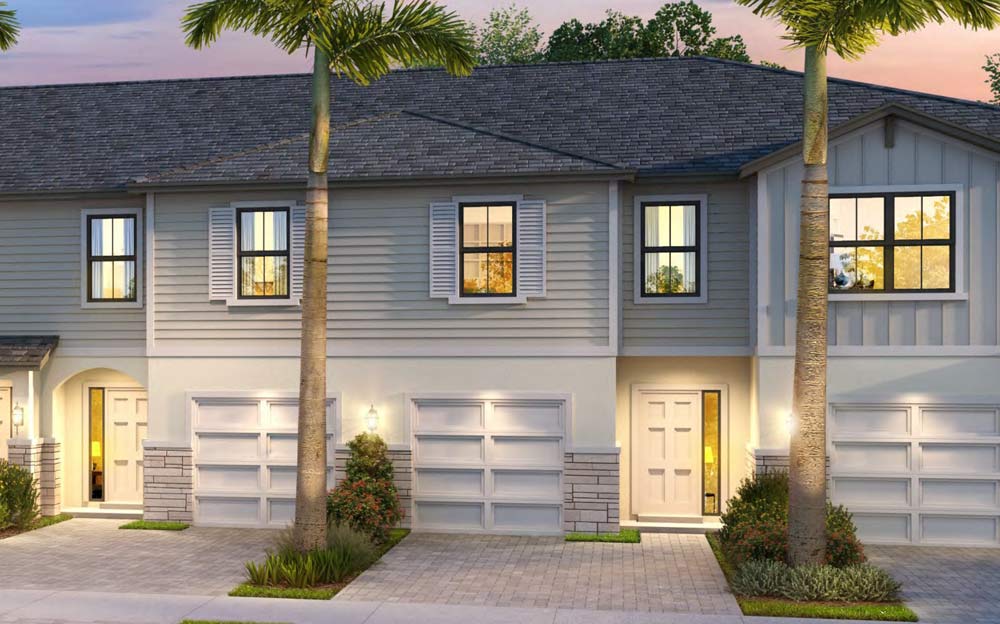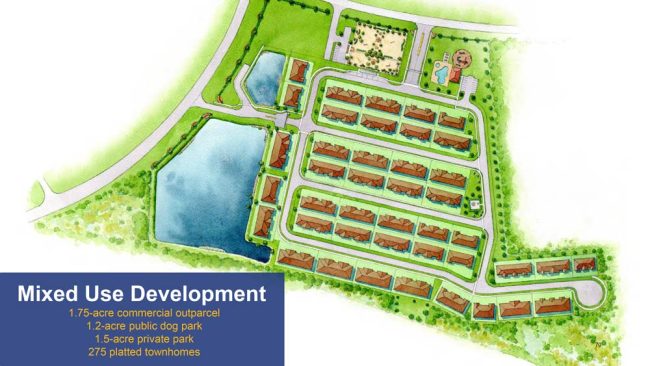
The Palm Coast City Council approved on first reading a rezoning that will lead to 275 town home at Belle Terre Boulevard and Citation Boulevard. The gated development will be called Belle Terre Estates and provide relatively modest-size attached apartments in two-level buildings.
The development itself did not get any pushback from the council. But city land use policy framing the vote did.
The 4-1 vote, with Council member Theresa Pontieri in dissent, led to a discussion–if not a debate–on what has become routine in the city’s ongoing residential development boom: time after time, land zoned for commercial use is being re-zoned for residential uses. In this case, the rezoning is taking place despite going against the city’s own Land Development Code in one regard: the town homes will be smaller than the code calls for.
The city called those departures “minor,” and determined, in city planners’ opinions, that “they’re more than offset by the donation of 1.2 acres of land” for a public dog park, in Senior Planner Bill Hoover’s words. The developer could have instead kept the acreage and extended its own commercial parcel, or sold off the acreage, Hoover said, though that seemed to contradict what he had just said: the developer needed to make the donation in order to have its 275-home development. Had it sold off the land, or kept it for commercial uses, there would have been no justification for the city to depart from its code.
“These townhome communities are meant to be low maintenance and appeal to retirees who want to downsize and who can’t or don’t want to maintain a yard pool or a large home,” Christina Evans, a planner working with the developer, told the council. “This community would also appeal to young professionals and couples. You don’t need a lot of space yet and you have a busy schedule.”
As she had before the city’s planning board last month, Evans described the gated community as “upscale without being unaffordable,” with units selling in the “two hundred thousands.”
The lots will be 19 feet wide and 90 feet deep, or 1,710 square feet in area. The land development code’s multi-family district requires lots to be 25 feet wide, and 2,500 square feet in area. Only the development’s end lot units are closer to meeting that requirement. “So this departure from the land development code standards is the reason they’re applying for a Master Planned Development rather than a straight rezoning” to multi-family residential,” Senior Planner Bill Hoover said.
A master-planned development has requirements of its own: public benefit. In this case, the developer is citing the public dog park as the public benefit. “It would be the city’s dog park,” Ray Tyner, the city’s planning director, said: the developer will build it with park impact fee credits, the city will maintain it.
“So if the public benefit for the smaller townhomes in the smaller yard sizes is a dog park, what is the public benefit for converting from commercial to residential?” Pontieri asked.
Pontieri has been concerned about the conversion of commercial land to residential land, and the concurrent further shift of the property tax base from commercial or industrial to residential. Pontieri wants the shift to go the other way. She’s not alone on that count in local government. But local officials rarely resist or object to rezonings that only add to the residential base. And having land designated for commercial uses doesn’t mean it’ll attract users: the 40-acre parcel in play is an example.

“We’ve heard the concern about getting rid of the commercial property within the city,” Tyner said. Belle Terre Estates would preserve 96,000 square feet of potential retail space. “This is not a major corridor, this is not Palm Coast Parkway. This is not State Road 100.” Nevertheless, he said, there’s still commercial potential to accommodate the area. “Would you see a Publix here? I don’t know. But can you accommodate it? With the square footage of the retail, yes.”
In fact, Publix made it clear to the land owner: it’s not interested in that area. Nor are other commercial entities. “The value in commercials greater than townhomes. So, initially, we did try to check and see if we can do something commercial there,” Mark Goldschmidt, the property owner, said. “But I reached out to different commercial players and the traffic counts, especially when you’re so close to highway 100, is not going to get to the numbers that they want.” The residential expansions to the east and north made no difference, not with State Road 100 right up the road.
Another parcel near Belle Terre Estates is developing 200 single family homes. Pontieri pressed the point: commercial is not developing, the reasoning goes, for lack of residents to support it. “So are we jumping the gun on converting this from commercial to residential when we know we’re going to have over 200 new rooftops within a year?”
Hoover said residents would not want “a 40-acre commercial project with big box stores.” The concept is to provide a “node” of neighborhood commercial facilities, a walkable area that would allow residents not to have to take their car to the more dense part of town for their shopping. But for now, that node is not there.
But 15.6 acres across the street from Belle Terre Estates are zoned for commercial (and designated mixed use). Nothing would stop that land owner from requesting a rezoning to residential area. That concerns Pontieri. “They can come back and do the same thing that this applicant is doing,” she said. “And so I continue to see more rooftops and rooftop and rooftops getting rid of commercial. We appear to talk about diversifying our revenues and lessening tax base on residential households. Yet, there’s nothing to say that the lot across the street will in fact, be commercial. I like this plan. I think that the concept of this plan is excellent. My fear is: are we saying one thing and doing another?”

“The final decision on that future issue that you’re addressing would be right up here at city council,” Mayor David Alfin said. “So we can caution ourselves on that.” But so far, the council as a whole has shown little interest in signaling caution.
Read Related Also: Met Police release more CCTV images of man they wish to speak to after two victims were stabbed in 'homophobic attack' outside London nightclub
The 40-acre site had been platted as a general commercial subdivision for years, but sat vacant due to a lack of demand for commercial development. Belle Terre Holdings acquired the site in December 2021.
The rezoning from commercial to Master Planned Development would reserve a 1.75-acre parcel for later development as retail or other commercial uses. There’s no commitment in that regard. City planners say two factors may lead to that point: the addition of housing (and therefore residents with wallets), and the ongoing extension of Citation Boulevard to Seminole Woods Boulevard, providing both a shortcut to I-95 and a likely increase in traffic in the area. That extension is expected to be completed in the summer or fall of 2024.
Pontieri, stressing that she had no issue with the project as a whole, was not convinced that the public benefit of the dog park was sufficient to allow the deviation from the city’s Land Development code. She proposed that 40 or 50 percent of the town homes be allowed to deviate from the code, but not the entire development, which she described as “shoving in a bunch more units” in through the deviation. “I’m just asking for a little bit of movement on this because, ” Pontieri said, addressing the developer, “at the end of the day, it’s dollars for you guys, I get that. But we still have to keep within the spirit of what Palm Coast code calls for.”
There is room for the developer and the city planners to tweak the project before the ordinance’s second reading. “I think those are great concerns, and I look forward to the adjustments that come back,” Council member Nick Klufas said. But too much tweaking is unlikely, given the council’s solid vote in favor of the applicant.

Aside from considerable questions about the dog park, the proposed development provoked indirect inquiry from Council member Cathy Heighter. She asked whether builders could consider apportioning some of their new construction to affordable housing, “because that’s something that’s hugely needed in this community,” she said. “The homes are beautiful, but we have working people that live in this community that need housing, and cannot afford these very expensive homes that are being built here.”
She asked the developer if some of the townhouses could be designated as “workforce units,” for affordability.
“The difficulty is that that word sometimes has a negative connotation depending on who you talk to,” Joey Posey, the land owner’s attorney, said.
“When you’re talking about our first responders, our firefighters, I don’t see where there’s a negative connotation,” Heighter said. “These are people that keep our community safe and up and running. So they need housing also.” The attorney said the town homes could be starter homes for some buyers.
Belle Terre Estates, Tyner said, does provide a fee-simple town house that will be smaller units with one-car garages. “So there isn’t a product out there that I know of like what is being proposed here to have some smaller units,” he said. “That in itself could bring the price down and also providing an availability of different housing types [that] can help bring that affordability level down as well.”
Alfin urged Heighter to take on the affordable housing message into the city’s rewriting of its comprehensive plan, the blueprint for long-term planning and development in the city.
But the mayor then made a startling proposal. He imagined zoning by class. He described what would essentially defeat the original intent of Palm Coast when ITT planned it–a mid-range community where classes mixed, without older cities’ sharply delineated neighborhoods by wealth, or lack of it.
Alfin said certain areas could be zoned or designated for affordable housing: “You might want to step forward and suggest that perhaps areas be zoned for or dedicated to whichever kind of housing you’re trying to define,” he said, “so that there is no pushback from the community, and that we already have set the expectation that we are going to provide housing product that is affordable to those that are working as first responders, teachers and city staff and on and on and on. But we will actually line out areas where that’s going to be the zoning requirement for them.”
The council’s second reading of the Belle Terre Estates ordinance will take place in two weeks.
![]()
belle-terre-estates










